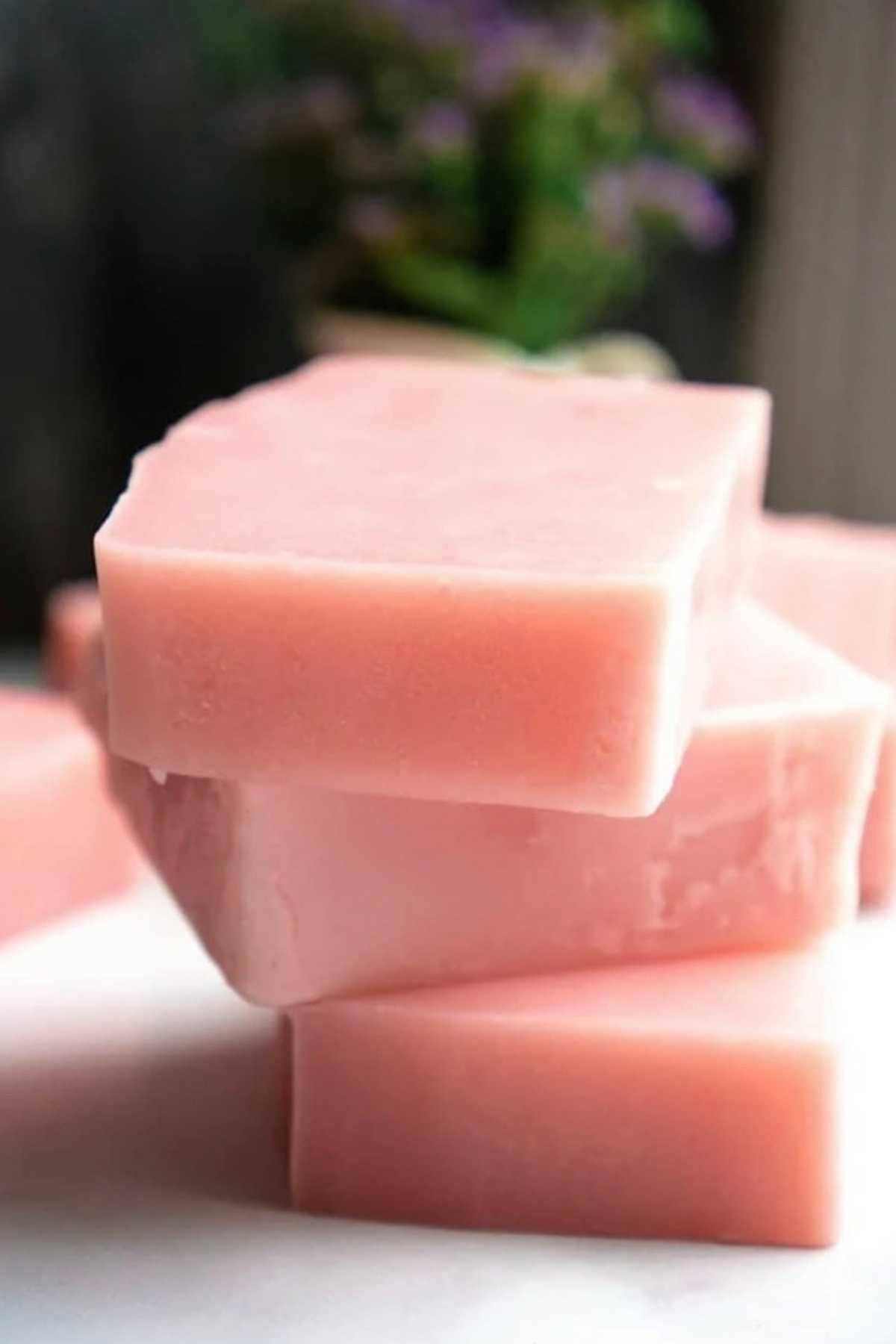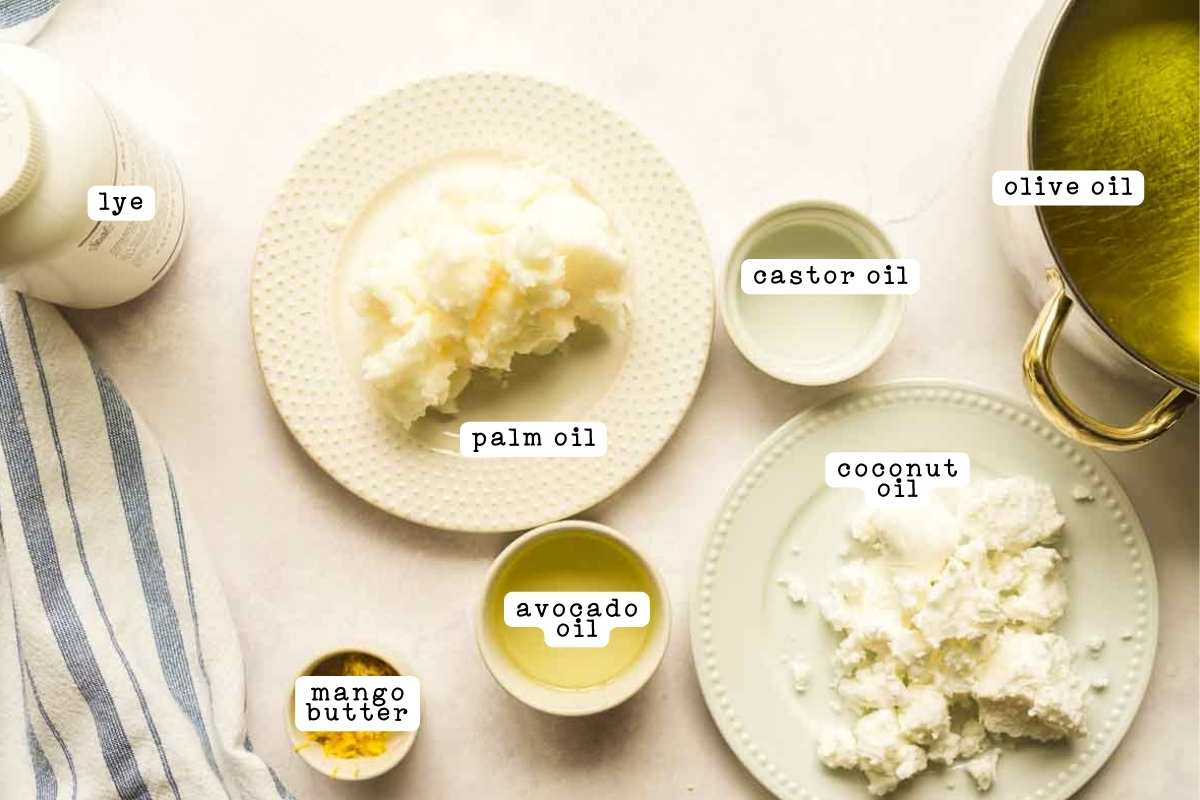How to Make the Best Cold Process Soap: Super Moisturizing and High Lather
This cold-process shower soap recipe is the best ever. It makes a moisturizing yet cleansing bar with tons of lather. Please read below the recipe for tips on substations, safety, and storage, as well as step-by-step photos. If you’re brand new to soapmaking, there’s a lot to learn! You’ll want to watch the video and read the whole post before you start.
The Best Cold Process Soap Recipe

Equipment
- Safety equipment (gloves, goggles, apron)
Ingredients
- 11 ounces coconut oil
- 9 ounces olive oil
- 9 ounces palm oil
- 2 ounces sweet almond oil
- 4 ounces castor oil
- 4 ounces avocado oil
- 2 ounces mango butter
- 5.83 ounces lye
- 10-15 ounces water
- 3 tablespoons fragrance oil for a strong scent, vary this to your preferences
- 2 teaspoons sodium lactate optional, for a harder bar
- colorant or mica optional
Save This Recipe
You'll join my email list which you will love. And if you don't, unsubscribe in one click. ❤️
Instructions
- Make lye water. Using a digital scale, measure out the lye and water in separate glass containers. Combine them by adding the lye to the water. (Remember: snow floats on the lake.). Stir until the lye dissolves. The temperature will shoot up. Place this in a safe place to cool.

- Melt oils and butters. While the lye solution is cooling, measure out the oils and butters and combine them in a large stainless pot. Melt them over low heat and heat them up to 130-140 degrees. Set them aside to cool.

- Let cool. After 2 hours, check the temperature of both solutions. They should be around 110 degrees. (A range of 100-120 is fine.). If not, allow them to cool longer.
- Prep for mixing. Prepare your mold and measure out any fragrance or color you will be adding. (For best blending of colors, mix some color into a few drops of melted oils.). If using sodium lactate, add it to the lye water at this time.
- Blend to trace. Pour the water and lye solution into the pot with the melted oils. Blend with a stick blender until thin trace is reached. The soap batter will noticeable thicken and a trail of soap will sit on top of the liquid rather than immediately sinking in. (This will take about 1 minute.). Add the color and fragrance and stir by hand.

- Pour in mold. Immediately pour the soap batter into the mold. Place in a turned-off oven or wrap with blankets to insulate the soap.

- Cut bars and let cure. After 24 hours of curing, unmold and cut into bars. The bars may seem slightly soft but will harden considerably during the curing process. Allow to cure at least 3 weeks in a well-ventilated place.

Video
Notes
Did You Make This?
I would love it if you would leave a review!
Ingredient Substitutions and Notes

- Coconut Oil: A staple in soap making, coconut oil provides a rich lather and hardness to the soap. It is highly cleansing and can strip away excess oil, making it ideal for oily skin types.
- Olive Oil: Known for its moisturizing properties, olive oil makes the soap smoother and less drying. It’s great for sensitive skin and contributes to the soap’s gentle cleansing ability.
- Palm Oil: Adds hardness to your soap bars, helping them maintain shape and last longer. It also contributes to lather quality, though it’s important to source sustainably due to environmental concerns.
- Sweet Almond Oil: This oil is excellent for its conditioning properties, adding softness and an elegant feel to the soap. It’s suitable for all skin types, especially dry skin.
- Castor Oil: A unique ingredient that boosts lather, making your soap rich and creamy. It’s also hydrating and helps draw moisture to the skin.
- Avocado Oil: Loaded with vitamins and minerals, avocado oil enhances the moisturizing power of your soap. It’s particularly good for dry and sensitive skin.
- Mango Butter: Provides a conditioning and moisturizing effect, making the soap more luxurious. Mango butter is rich in antioxidants and can help to soothe and soften the skin.
- Lye (Sodium Hydroxide): Essential for saponification, the chemical reaction that creates soap. Lye must be handled with care, but it is completely safe once the soap has cured.
- Water: Acts as a solvent for the lye and helps to control the saponification process. Distilled water is best to prevent any impurities from affecting the soap.
- Fragrance Oil: Adds a personal touch to your soap with your favorite scents. Quality fragrance oils are designed to be skin-safe and can significantly influence the sensory experience of using your soap.
- Sodium Lactate (optional): A salt solution that makes the soap bar harder and easier to unmold. While optional, it’s beneficial for achieving a smoother finish.
- Colorant or Mica (optional): These additives bring vibrant colors to your soap, enhancing its visual appeal. They can be used to achieve a wide range of artistic effects, like swirls or layers.
Storage Instructions
Once fully cured, homemade soap should be stored in a dry, well-ventilated spot. I like to put it in shoe boxes in the closet with layers of newspaper in between the bars.
While it is in use, use a soap saver to keep your bar dry. It will last much longer.
Common Issues and Fixes
A 10-inch silicone mold. It’s my favorite for most soaps.
If your soap is too soft, it might need more time to cure. Adding sodium lactate or using oils with higher stearic acid content can also help create a harder bar.
It is a pink mica from Nurture Soap. You can find it here.
Yes, absolutely. I’d recommend using sodium lactate since it can be a bit soft when unmolding it.
This is a 100% personal preference (except for the fact that florals are more difficult to work with). My personal favorites are Comfort and Joy from Nurture Soap and Mango Mango from Brambleberry.
Yes! I used to swirl it all the time before I got too lazy.
You sure can. You’ll need the following percentages:
Coconut Oil: 26.83%
Mango Butter: 4.88%
Olive Oil: 21.95%
Palm Oil: 21.95%
Sweet Almond Oil: 4.88%
Enter them into a soap calculator with the desired size of your batch and it will give you the correct amounts.
The gel phase is a part of the saponification process where the soap heats up and becomes translucent. This can help create a smoother, more uniform bar.
Yes, essential oils can be used as a natural alternative to fragrance oils. Just be sure to use skin-safe essential oils and follow recommended usage rates.
This recipe is a great way to start, but if it’s your first time, you might want to try a more basic recipe with fewer oils. Cold process soapmaking can be complex, so starting simple is a good idea.
Distilled water is free from impurities that can affect the chemical reaction during the saponification process. Using distilled water ensures a more consistent result.
More Great Cold Process Soap Recipes:
- Mix-ins are fun! Try this gardener’s soap recipe.
- You can make your own bar dish soap.
- If you’re looking for something palm-free, try my grapefruit soap bar.
As you continue soap-making journey, remember the importance of safety, stay patient and careful, and enjoy of crafting something with your own hands.
Love,















Hi Katie, I love your soap making recipes. I’m new to soaping. I intend to try out this recipe.
Hi Lori, I’m a newbie. I’m wondering how much water to use. 10-15 oz seems like a wide range and I don’t know what the effect would be of using more or less. Thanks.
For your first time, go with 12.5. More water will come to trace slower and give you more time to add mix-ins. Less water will move a lot faster but as a benefit it will cure and dry faster. The middle is the good start )
Thank you, that’s very helpful!
I am having a problem with my soap loosing it’s scent during curing. After about 2 days it smells like playdough. The bars come out beautiful looking but they do not smell good. What can I do about my ever frustrating issue? I follow recipes to a T.
Just increase the amount of fragrance oil. it will be quite overwhelming at first but as the soap cures, it will fade. you can also try kaolin clay mixed in to get the scent to stick. )
i made this soap recipe and i can honestly say its the best soap i ever made.
My daughter has a coconut allergy. What could I substitute for the coconut oil?
I made this soap a few days ago. I haven’t been able to use it, of course, but I am pleased with the bars. I do have these comments.
The recipe was too much for my standard silicone loaf pans, around 42 oz. I believe. Amazon sells one that is over 60oz. so I will probably get one of those for the next batch. I mixed the lye water and oils at 120 degrees. I did not add the sodium lactate, or any fragrance or color, but the mixture went to a pretty hard trace more quickly than I was expecting. Next time I will allow them to cool to 100 – 110 degrees. Could that temperature difference make a difference? I put the loaf in a warmed oven (turned off) and it was great. I was surprised at how warm the oven was several hours later. The next morning, the soap looked great and I am excited to use it! Thank you for this recipe!
Katie, thank you for posting this recipe. I made the recipe for beginners from Bramble Berry and liked it very much but I wanted to add a little more to Ann Marie’s recipe, and was thinking what to add. I just happened to come across your site and was very pleased to see your recipe for this lovely bar of soap. I will definitely try your recipe. So thank you again.
The first 2 times I made this recipe, my soap was perfect! I loved this recipe.. i just made 2 new batches and neither turned out very well. With 5 seconds ( if even that long) of adding the lye to the oils, the mixture was hardening! Looking at your recipe above, I realized I put 3 teaspoons of sodium lactate to my lye solution, instead of 2. Could that be the cause of my failure?
yes more sodium lactate will cause it to harden faster, but I’m not sure a teaspoon would be that dramatic of a difference. have you tried a new fragrance? that can have a huge effect. especially floral fragrances will cause the batter to hardenr right away.
I was wondering this lye stuff is it the same stuff you get at walmart or is it special for soap.
you can use the kind at walmart that’s made for unclogging drains as long it is says 99% pure sodium hydroxide
Ok i have another ? i bought coconut oil at hobby lobby but its the liquid is that ok to use or should i get the solid. and out of all the oils you put in this recipe should any of them be solid. thank you so much for getting back to me i appreciate it.
Hello Katie , can i use liquid coloring with this soap?
Hey, I’m new to soap making and have been having trouble with what scents to use. I just bought P&J scents and they’re really small, and not enough. So, I was wondering if you could send me the link to the website where you get your scents from and the amount of scent you use in a batch. Thank you!
Hi Taylor, I use Nurture Soap: https://nurturesoap.com?aff=326. I love their fragrances
Use michaels or hobby lobby
Don’t like negative comments like the one in here. However I have been doing soap for awhile now and love it. Its the easiest way to make mothers day, birthday, and Christmas gifts and still have a wonderful gift to give someone. However, I came across yours and thought, you were using more oils then most of the others and I think this will be fun to try. I wanted one that had more fat or at least enough fat. I have psoriasis arthritis and my skin hates me so, I’m gonna see if this one helps. I’m hopeful ☺️ I will let you know thank you for sharing with us.
I haven’t made this recipe yet but wonder if I can substitute shea butter for the mango butter? The only reason for this is that I already have shea butter on hand.
yes i’ve run that through a soap calculator and it works!
The oddest thing happened when I made a batch of this. I measured exactly, waited for both oils and lye/water solution were at 110 degrees. Mixed both together for a quick second and then added my essential oils. I used lemongrass and sandlewood. It came to trace super super fast, looked like cottage cheese in a split second, so I transferred to my mold. I knocked out what I thought were as many bubbles that could surface and stepped back to be thoroughly disappointed. I cleaned my tools and went back to transfer the ugly batch of soap to my waiting area and the entire batch was liquid. I went ahead and stirred it until it started to setup, covered it in towels and walked away. Not sure what will come of all of this, but I’ve never had any of your recipes act like this. Any ideas? I’m at 7,000 ft altitude and I’ve always wondered if a batch of stuff (like cooking) doesn’t work out it is because of the altitude.
Hi Jan, Are you using a new fragrance oil by any chance? Sometimes one with a lot of florals in it will cause your soap to seize up (the cottage cheese texture you described), but it hadn’t fully come to tract it would stay liquid. That’s the only thing I can think of. I hope it set up for you!
No new fragrance, same essential oils I normally use. It setup after 24 hours and I was able to cut the bars. It was the weirdest thing. The bars are not all uniform in structure, some areas more translucent than others. Now to wait and see how it cures. Thanks for the reply, I’ll let you know how they turn out. BTW, Your recipes turn out better than most I try. Thanks for the awesome resources.
To be honest – by look at this recipe… soap will be drying. No way that soap with almost 27% od coconut oil won’t dry you out, unless you superfat it at about 8-10%… and then there will really small lather. Too much expensive, useless oils. I bet that my basic much more simple recipe will beat this soap.
When I was starting, I thought that more=better… in soapmaking it is opposite.
That’s a very arrogant comment about Katie’s recipe especially if you can’t produce yours for viewers to test.
If you can’t walk your talk then shut up… Just saying😜
This is a wonderful recipe- I do trust her recipes and if there has ever been a problem- it was operator error. ME. You are a good person Lelani- arrogant trolls are everywhere. So is envy- a very ugly thing indeed. I Love love love watching Katie’s videos.
Andrzej Strzelecki, that was a very rude comment you made about this recipe. I’ll bet you didn’t even try to make it did you? How in the world can you say anything about Katie’s recipe unless you try making it? Very poor behavior. “I bet that my basic much more simple recipe will beat this soap” So rude and bragging on yourself is disgusting to read. Just how old are you, son ?
Approximately how many bars will this make? I don’t know whether to size up or down because I don’t know how much it makes. What size mold makes a huge difference, but as an average size bar goes, 2×3″ or thereabouts.
Measure your loaf pan you are using length x width x height = volume x .40 = oil amounts needed and take to soapcalc.net and enter the percentages and you will come up with the exact amount of each oil to use in grams or ounces, whichever you prefer. Watch YouTube for how to make soap for beginners and when you feel confident, you can make this recipe. Hope this helps a little.
Kathy M.
PS You can watch Soap Queen, MoRiverSoap, Jerika Zimmerman Soap Making tips and many more. Good luck.
I used this recipe for my first try at soap making. I am so pleased with the results that I can’t image ever being without this soap. I calculated an 8% super fat and used no coloring or scent.
Sorry, this comment should be for the cold process baby soap.
lana so happy you loved it!! 8% super fat is great for this recipe
Hi Katie,
I want to test this out but size it down. What superfat% did you run this at?
5%
Katie Shaw your recipe sounds awesome. Does it make a hard, medium or soft bar of soap?
it’s pretty soft so i recommend adding the sodium lactate!
Hi Katie I did make your The Best Cold Processed Soap recipe and have received nothing but compliments on it! About to make another batch tonight. My question is how did you get it to turn pink? My soap turned out an orange color I think due to the organic palm oil? I also added calendar flowers throughout the soap and it truly is amazing on the skin! Thanks for all your hard work and recipes that you offer I truly appreciate them!
Hi enjoyed your soap making the pretty pink of your soap caught my attention I will definitely make it thank you.
New to soap making. Love your recipe. 2nd batch I used 14 oz of water, no sodium lactate but it still got too thick too fast to swirl. Any suggestions?
hi lori! it could have been a fragrance that sped things up, or maybe your oils cooled too long.